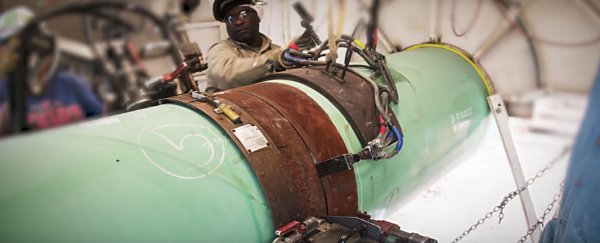It didn't take long for detractors of the Dakota Access Pipeline to have their fears met, with reports surfacing that the facility sprung two leaks in March, leaking more than 100 gallons (378 litres) of oil before it was contained.
While both leaks were relatively small, and were cleaned up before affecting nearby waterways and wildlife, the concern here is that the pipeline has now sustained three leaks in 2017 alone, and it still hasn't even begun operations.
As the Associated Press reports, two barrels of oil totalling 84 gallons (320 litres) spilled on March 3 due to a mechanical fault at a pipeline terminal in Watford City, North Dakota.
A second, above-ground spill occurred on March 5 in Mercer County, North Dakota - a leak of half a barrel, or 20 gallons (75 litres), due to a manufacturing defect. The contaminated soil was reportedly cleaned up before doing any damage to the surrounding environment.
A third, known leak occurred on April 4 in South Dakota, where two barrels (84 gallons) spilled at a pump station.
The North Dakota Environmental Health Chief, Dave Glatt, told the Associated Press that all spills are listed on their online database, but they don't usually notify the public unless the leaks involve at least 150 barrels (6,300 gallons or 23,848 litres), or the oil has made its way into the waterways.
To be clear, these leaks are tiny compared to what we've been seeing elsewhere in the state of North Dakota, which has experienced 700 oil spills in the past 12 months alone.
One of them occurred in Billings County, just 2.5 hours away from where the Standing Rock protest took place, when a December 2016 spill leaked 529,830 gallons of crude oil (12,615 barrels or 2,005,624 litres) into Ash Coulee Creek and the surrounding countryside, due to a fault in the Belle Fourche Pipeline.
Especially concerning for locals was the fact that the company that owns the leaky pipeline, Belle Fourche Pipeline Co., didn't even realise it was happening until a member of the public stumbled on the leak and notified them about it. And that was five days after the leak had originally sprung.
By that stage, the oil had spread almost 7 km (5.4 miles) from the original leakage point.
Another leak saw 400 barrels of oil (16,800 gallons) leak out in Bowman County, and spread more than 100 metres into the surrounding environment.
Between 2006 and 2014, there have been more than 1,300 pipeline spills in the state, according to The New York Times.
But the fact that the Dakota Access leaks have so far been small will be cold comfort for concerned locals, who say it's only a matter of time before a bigger, and more environmentally damaging incident occurs.
"We have always said it is not a matter of it, but when," tribal attorney Jan Hasselman told the press after the 84-gallon South Dakota leak. "Pipelines spill and leak. It's just a fact."
Several tribes in North and South Dakota, including the Cheyenne River, Standing Rock, Yankton, and Oglala Sioux, are currently fighting the Dakota Access Pipeline in federal court.
